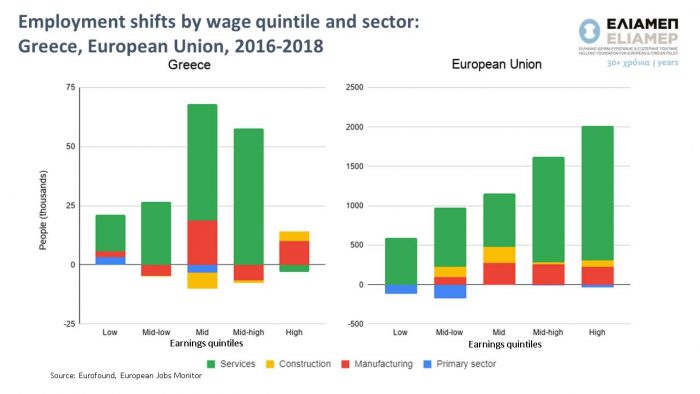The period preceding the Covid-19 pandemic was marked by a strengthening of the labour market dynamics. In Greece, following a deep ten-year crisis, employment started to increase and the unemployment rate declined. Other European countries also showed a slight improvement. As changes in the labour market are due, inter alia, to the relocation of workers to new jobs, it is interesting to observe these jobs’ characteristics, both in terms of wages and by sector.
In the graph above, we draw data from the European Jobs Monitor (EJM). The EJM monitors structural changes in European labour markets and helps us to qualitatively assess these changes using relevant indicators. It covers all EU members states and is based on data from the Labour Force Survey at a European level. The graph shows the breakdown of new jobs in Greece (left panel) and the European Union (right panel) as estimated by employee turnover. The vertical axis shows the net change in the movements of employees (in thousands) per quintile of wages, which is then distributed to the sectors where these movements are observed. The data covers the 2016-2018 period.
Observing the graph and comparing the changes in Greece and the EU, one can make three interesting observations.
First, there has been an increase in the net number of workers moving to new jobs, both in Greece and in the EU. However, while the increase in positions in the EU is growing by quintile of wages, in Greece the majority of movements is concentrated in the medium to high wage scale (third and fourth quintiles). The increase in the top quintile in Greece is the smallest, indicating a significant lag in quality, high-paying jobs compared to the EU average.
Second, the majority of movements to new jobs in Greece and the EU concern the services sector, with those in industry and manufacturing following at a considerable distance. We note, however, that while in the EU the highest paid new jobs are mostly in the services sector, the highest paid new jobs in Greece are dominated by the secondary sector. This fact indicates a lack in Greece of new jobs in high productivity services.
Third, while the primary sector in the EU, as reflected in new jobs, is losing ground relative to other sectors, in Greece it seems to be returning, at least in terms of low-paid jobs. This feature partly indicates the restart of the primary sector after the crisis. However, given that the majority of jobs in this sector remain in low wage quintiles, we highlight the need for both the restructuring of this important sector for Greece, with the aim of producing high value-added products, as well as the creation of jobs in other sectors with higher productivity.




